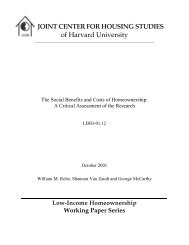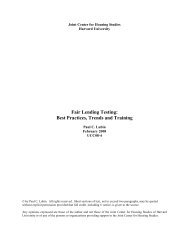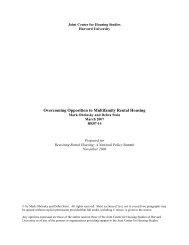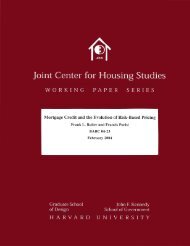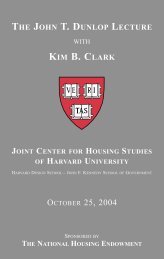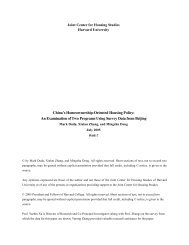please do not cite or circulate without permission of the authors
please do not cite or circulate without permission of the authors
please do not cite or circulate without permission of the authors
Create successful ePaper yourself
Turn your PDF publications into a flip-book with our unique Google optimized e-Paper software.
community districts with Nehemiah <strong>or</strong> Partnership developments and because those<br />
b<strong>or</strong>oughs include a large share <strong>of</strong> smaller properties which sell m<strong>or</strong>e frequently than<br />
apartment buildings (m<strong>or</strong>e common in Manhattan and <strong>the</strong> Bronx). The figure also shows<br />
that over a third <strong>of</strong> <strong>the</strong> transacting properties had garages and 80 percent were built<br />
bef<strong>or</strong>e W<strong>or</strong>ld War II. Only a handful <strong>of</strong> buildings were vandalized <strong>or</strong> o<strong>the</strong>rwise<br />
aban<strong>do</strong>ned. Finally, <strong>the</strong> figure also shows that 4.1 percent <strong>of</strong> <strong>the</strong> properties in our sample<br />
are located within 500 feet <strong>of</strong> a Partnership <strong>or</strong> Nehemiah site (whe<strong>the</strong>r completed <strong>or</strong> <strong>not</strong>),<br />
10.6 percent are located within 1,000 feet, and 24.5 percent are located within 2,000 feet<br />
<strong>of</strong> one <strong>of</strong> <strong>the</strong> homeownership developments.<br />
The second column reveals some systematic differences between properties located<br />
close to Nehemiah <strong>or</strong> Partnership sites and those that are <strong>not</strong>. Due to <strong>the</strong> location and<br />
concentration <strong>of</strong> Partnership and Nehemiah developments, properties located within <strong>the</strong><br />
500-foot ring are much m<strong>or</strong>e likely to be in Brooklyn, Manhattan, <strong>or</strong> <strong>the</strong> Bronx.<br />
Properties in <strong>the</strong> ring are also much older, much less likely to be single-family homes,<br />
m<strong>or</strong>e likely to be walk-up apartments, and consistent with <strong>the</strong>se differences, much less<br />
likely to have garages.<br />
Third, <strong>the</strong> New Y<strong>or</strong>k City Department <strong>of</strong> Housing Preservation and Development has<br />
provided us with data on <strong>the</strong> precise location (<strong>do</strong>wn to <strong>the</strong> block level) <strong>of</strong> all housing<br />
built through <strong>the</strong> Nehemiah and Partnership programs. Figure 2 shows <strong>the</strong> location <strong>of</strong><br />
<strong>the</strong>se projects in <strong>the</strong> city. As shown, most <strong>of</strong> <strong>the</strong> projects have been built in Brooklyn and<br />
<strong>the</strong> Bronx. Figure 3 indicates that 12,468 <strong>of</strong> <strong>the</strong> 15,528 units (80 percent) are in Brooklyn<br />
<strong>or</strong> <strong>the</strong> Bronx and that over 13,000 (85 percent) were completed during <strong>the</strong> 1990s. As f<strong>or</strong><br />
building type, 90 percent <strong>of</strong> <strong>the</strong> Nehemiah units are single-family homes, as compared to<br />
just 12 percent <strong>of</strong> <strong>the</strong> Partnership units. Partnership units are instead m<strong>or</strong>e typically twoand<br />
three-family homes.<br />
Figure 4 compares <strong>the</strong> average 1990 characteristics <strong>of</strong> census tracts that include<br />
Nehemiah and Partnership units in 1998 to those that <strong>do</strong> <strong>not</strong>. 11 The 2,938 Nehemiah units<br />
have been built across 25 census tracts in <strong>the</strong> city (118 units per tract on average). The<br />
Partnership units have been m<strong>or</strong>e dispersed, with each <strong>of</strong> <strong>the</strong> Partnership census tracts<br />
housing an average 70 Partnership homes.<br />
11 The census tract data is taken from <strong>the</strong> 1990 Census. Tracts are characterized as including Nehemiah <strong>or</strong><br />
Partnership projects, even if <strong>the</strong>se projects were <strong>not</strong> built until later in <strong>the</strong> decade.<br />
13



